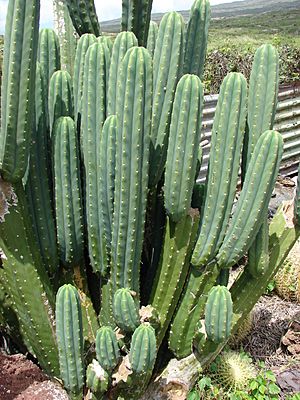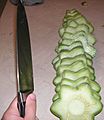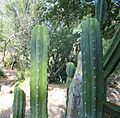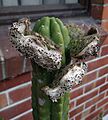Echinopsis pachanoi facts for kids
Quick facts for kids Trichocereus macrogonus var. pachanoi |
|
|---|---|
 |
|
| In Hawaii | |
| Conservation status | |
| Scientific classification |
|
| Kingdom: | Plantae |
| Clade: | Tracheophytes |
| Clade: | Angiosperms |
| Clade: | Eudicots |
| Order: | Caryophyllales |
| Family: | Cactaceae |
| Subfamily: | Cactoideae |
| Genus: | Trichocereus |
| Species: |
T. macrogonus
|
| Varietas: |
T. m. var. pachanoi
|
| Trinomial name | |
| Trichocereus macrogonus var. pachanoi (Britton and Rose) Albesiano & R.Kiesling 2012
|
|
| Synonyms | |
|
|
The Trichocereus macrogonus var. pachanoi is a type of cactus often called the San Pedro cactus. It grows quickly and has a tall, column-like shape. You can find it in the Andes Mountains, high up at about 2,000 to 3,000 meters (6,500 to 9,800 feet) above sea level.
This cactus is native to Ecuador, Peru, and Colombia. It also grows in Argentina, Bolivia, Chile, and Venezuela. People grow it in other parts of the world too. For thousands of years, it has been important in traditional Andean culture. It is used in traditional medicine and is also a popular ornamental plant in gardens.
Contents
About the San Pedro Cactus
What It Looks Like
The San Pedro cactus has stems that are light to dark green. Sometimes they have a slightly bluish-gray coating. These stems are usually 6 to 15 centimeters (2.4 to 5.9 inches) wide. They typically have 6 to 8 ribs running along their length.
Small, whitish spots called areoles grow on the ribs. These spots can produce up to seven yellow to brown spines. Each spine can be up to 2 centimeters (0.8 inches) long. However, many cultivated San Pedro cacti have shorter spines or are mostly spineless. The areoles are spaced about 2 centimeters (0.8 inches) apart.
This cactus usually grows 3 to 6 meters (10 to 20 feet) tall. It often has many branches that grow from its base. If a branch breaks, new ones can grow around the broken area. The tallest San Pedro cactus ever recorded was 12.2 meters (40 feet) tall!
White flowers bloom at the ends of the stems. They open at night and stay open for about two days. A healthy cactus can produce many flowers over several weeks. These flowers are large, about 19 to 24 centimeters (7.5 to 9.4 inches) long. They can be up to 20 centimeters (7.9 inches) wide and smell very sweet. The thick base leading to the flower has black hairs.
After the flowers are fertilized, dark green, oval-shaped fruits appear. These fruits are about 3 centimeters (1.2 inches) wide and 5 to 6 centimeters (2.0 to 2.4 inches) long. When they ripen, they burst open. Inside, you'll find white flesh filled with many tiny seeds.
How Scientists Classify It
Scientists give plants special names to organize them. The San Pedro cactus was first described in 1920. It was called Trichocereus pachanoi back then. Over time, scientists also placed it in other plant groups, like Cereus and Echinopsis.
In 2012, it was reclassified as a variety of Trichocereus macrogonus. This means it's a specific type within the Trichocereus macrogonus group. You can tell it apart from other varieties by its fewer spines per areole. It also usually has slightly shorter and thinner stems.
The San Pedro Cactus in Culture
Ancient Uses and Cultural Importance
The San Pedro cactus is known by many names in South America. Some of these names include achuma, huachuma, wachuma, aguacolla, hahuacollay, lapituq, tsuná, San Pedro, or giganton. It has a very long history in Andean traditional medicine.
Archaeologists have found proof that people used this cactus over two thousand years ago. It was important to ancient cultures like the Moche, Nazca culture, and Chavín culture. Even after the Spanish arrived and tried to stop its use, it continued to be important. This is why it got the Christian name "San Pedro cactus," which means Saint Peter cactus.
People believed that, just as Saint Peter holds the keys to heaven, the cactus helped them connect with spiritual ideas or gain insights. In 2022, the Peruvian Ministry of Culture officially recognized the traditional use of the San Pedro cactus in northern Peru as part of their cultural heritage.
Growing San Pedro Cactus
Caring for Your Cactus
The San Pedro cactus can grow in USDA hardiness zones 8b to 10. This means it can handle minimum temperatures between -9.4 °C and 10 °C (15 °F and 50 °F). Since it naturally grows high in the Andes with lots of rain, it can survive colder temperatures than many other cacti.
It needs soil that is rich in nutrients and drains water well. A good soil mix often includes light, inorganic materials like pumice or perlite. These plants can grow up to 30 centimeters (12 inches) each year.
Be careful not to over-water them, as they can get fungal diseases. However, they are not as sensitive as many other cacti, especially when it's warm and they are actively growing. Too much direct sunlight can cause them to get sunburned. This might make them look yellow.
In winter, if there isn't enough light, the plants might become thin and stretched. This is called etiolation. This can be a problem because the thin part might not be strong enough to support new growth. Strong winds could even break the cactus. In Oaxaca, Mexico, people often plant them close together to create a strong cactus fence.
Making New Plants from Cuttings
You can easily grow new San Pedro cacti from cuttings, just like many other plants. This method creates a genetic clone of the parent plant. This is a popular way to grow more of a favorite cactus. Sometimes, small cuttings are even grafted onto faster-growing cacti. Some popular types that collectors like are Ogunbodede, Vilcabamba A, and Yowie.
You can also lay a cactus column on its side on the ground. Over time, roots will grow from it into the soil. Then, new sprouts will form and grow upwards along the length of the column.
Growing from Seeds
Like many of its relatives, the San Pedro cactus is easy to grow from seeds. A common method involves sowing the seeds into plastic containers, like those used for food takeaways. This creates a mini-greenhouse with controlled humidity for several months. The seeds can sprout and grow without much disturbance from the outside environment. To help the seedlings grow even faster, they can be grafted onto other plants like Pereskiopsis.
Rules for Growing San Pedro Cactus
In many countries, it is perfectly legal to grow the San Pedro cactus in your garden or as a houseplant. However, because it contains certain natural compounds, using it for consumption is against the law in many places. It's important to always check the rules in your area.
Images for kids
See also
 In Spanish: Echinopsis pachanoi para niños
In Spanish: Echinopsis pachanoi para niños
- Chavín de Huántar
- Cimora
- El Paraíso, Peru
- Guitarrero Cave
- Stela of the cactus bearer
























